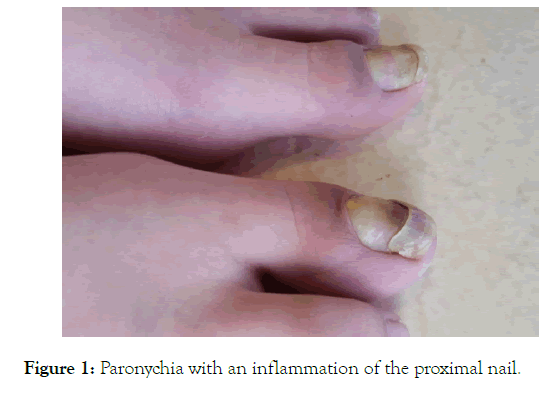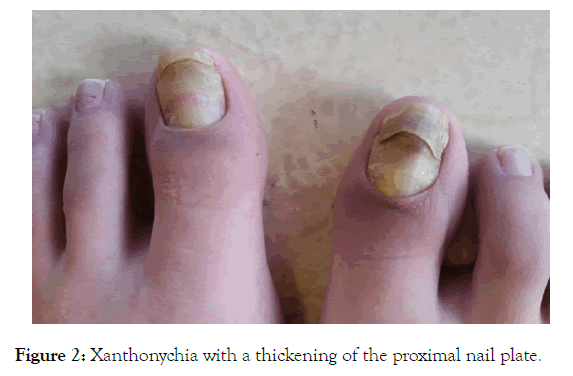Journal of Clinical & Experimental Dermatology Research
Open Access
ISSN: 2155-9554
ISSN: 2155-9554
Clinical image - (2019)Volume 10, Issue 6
An 18 year-old female patient presented to our department for a 6 month history of pain and dystrophy affecting the two great toenails. Previous treatments with antibiotics and foot baths had not improved the condition.
An 18 year-old female patient presented to our department for a 6 month history of pain and dystrophy affecting the two great toenails. Previous treatments with antibiotics and foot baths had not improved the condition [1,2] . Physical examination revealed a painful paronychia with an inflammation of the proximal nail and a xanthonychia with a thickening of the proximal nail plate that had a deep transversal split (Figures 1 and 2).

Figure 1. Paronychia with an inflammation of the proximal nail.

Figure 2. Xanthonychia with a thickening of the proximal nail plate.
The diagnosis of retronychia was highly suspected and a complete nail avulsion was performed under regional anesthesia, allowing a confirmation of the diagnosis as multiple generations of nail plates were found under the proximal nail fold [3]. The evolution was favorable with a complete resolution of the symptoms within a few days and a regrowth of a normal nail plate after two mouths.
Retronychia is an ingrowth of the nail plate under the proximal nail fold forming multiples stacking nail generations underneath. In case of proximal paronychia, xanthonychia, and disruption of linear nail plate growth the diagnosis of retronychia should be suspected allowing appropriate and early treatment [4].
Nil.
None.
Citation: Mai S, Palamino H, Belmourida S, Meknassi I, Senouci K (2019) A Painful Nail Disorder. J Clin Exp Dermatol Res. 10:511. DOI: 10. 35248/2155-9554.19.10.511
Received: 05-Nov-2019 Accepted: 15-Nov-2019 Published: 22-Nov-2019
Copyright: © 2019 Mai S. This is an open-access article distributed under the terms of the Creative Commons Attribution License, which permits unrestricted use, distribution, and reproduction in any medium, provided the original author and source are credited.